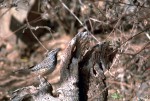
Click On Picture for Larger Image
Cactus Wrens
Author: Patsy Jones
 Click On Picture for Larger Image |
Species: Campylorhynchu bruuneicapillus |
Description:
Cactus wrens are the largest North American wrens and range in size from 7-8¾” (18-22 cm). They are energetic birds with slim, slightly curved bills. They have heavy black
spots clustered on their breast and rusty brown- and white-streaked upperparts. Their heads have a brown
cap with a broad white stripe over their eye. They also have white spots on their outer tail. In flight,
the long tail is spread, revealing a striking pattern of black and white bands. Males and females are
similar. Juveniles do not have the cluster of black spots on their throats; instead they have evenly spaced
fine dots on a background of buffy white.
Geographic range:
Cactus wrens are common and widespread in the desert regions of
the southwestern United States. They live year-round from southeastern California to southeastern Texas.
Their range also extends into Mexico and the Baja Penisula.
Habitat:
Cactus wrens are found in semidesert and desert communities with large
cactus, arid hillsides, and gravelly bottomed valleys. They are abundant year-round wherever cactus and
mesquite grows. They also can be found in brush alongside rivers and streams and in residential areas
where they nest in man-made structures.
Food Web:
Cactus wrens are busy and active birds, constantly searching for
food: insects, spiders, grasshoppers, lizards, and fruits and seeds in the winter, especially cactus
fruits. Sometimes they feed on the ground, digging in the soil for food with their curved bills. Their
nests are built in heavily-armored cactus which protects them from most predators. However, a few snakes
such as the gopher snake or whipsnake may make it into their nests for young cactus wrens.
Reproduction and Development:
Cactus wrens build dome-shaped nests deep inside the
protection of cacti (particularly cholla cactus), yucca, and mesquite. They will often build several nests,
facing different directions for protection from weather. Often they will use one nest for raising young
and a different nest for sleeping. Nests are built by the males and are made of stems, plant fibers, and
grass lined with feathers and fur. 2-7 pinkish-brown eggs are laid. Cactus wrens are monogamous birds. The
eggs are incubated for 16 days by the female. The young stay in the nest for 19-23 days, fed by both the
male and female. Pairs will produce 2-3 broods of young each year depending on the availability of
food.
Behavior:
Cactus wrens are conspicuous and noisy—making a very unbirdlike song that
is a low chug-chug-chug, gaining rapidity. Or, they may just sit atop a high perch such as a post or high
bush making a loud squawking chatter. They usually live in pairs or small family groups. When disturbed,
they may run on the ground like a thrasher rather than flying.
Conservation:
The numbers of cactus wrens in parts of California and Texas are
declining as development of desert communities causes habitat fragmentation. However, they are still common
in other areas of desert environments and are not considered endangered.
Taxonomy:
Kingdom: Animalia
Phylum: Chordata
Subphylum: Vertebrata
Class: Aves, Birds
Order: Passeriformes
Family: Troglodytidae
Genus: Campylorhynchus
Species: Campylorhynchu bruuneicapillus
References:
Alsop, Fred J. III. 2001. Birds of North America. New York: DK
Publishing, 998 p.
Forshaw, Joseph; Steve Howell, Terence Lindsey, Rich Stallcup. 1994. Birding. Time Life Inc., 288
p.
Peterson, Roger T. 1990. A Field Guide to Western Birds. Boston : Houghton Mifflin, 432 p.
Tweit, Susan J. 1992. The Great Southwest Nature Factbook. Seattle : Alaska Northwest Books, 223 p.
Tweit, Susan J. 1998. Seasons in the Desert. SanFrancisco : Chronicle Books, 223 p.
Related Terms: Chordata, Aves